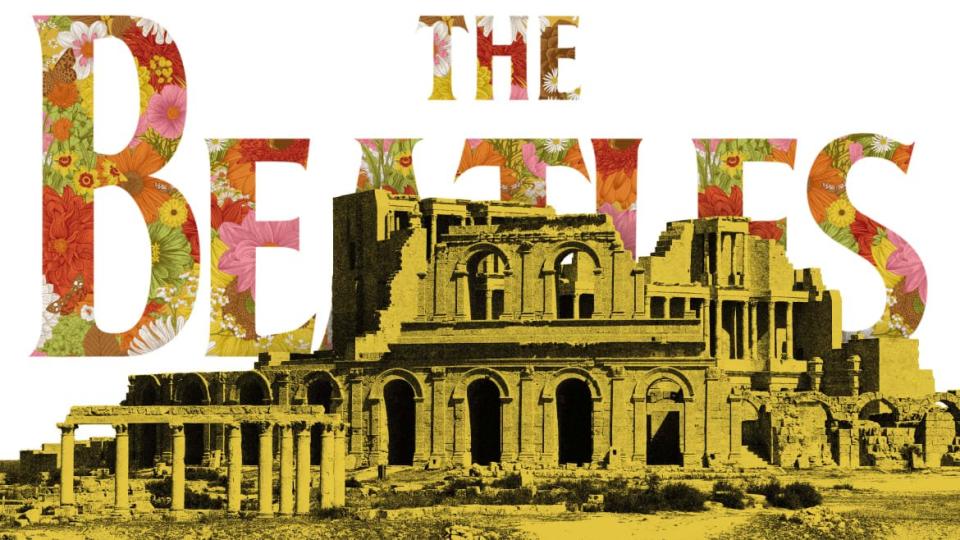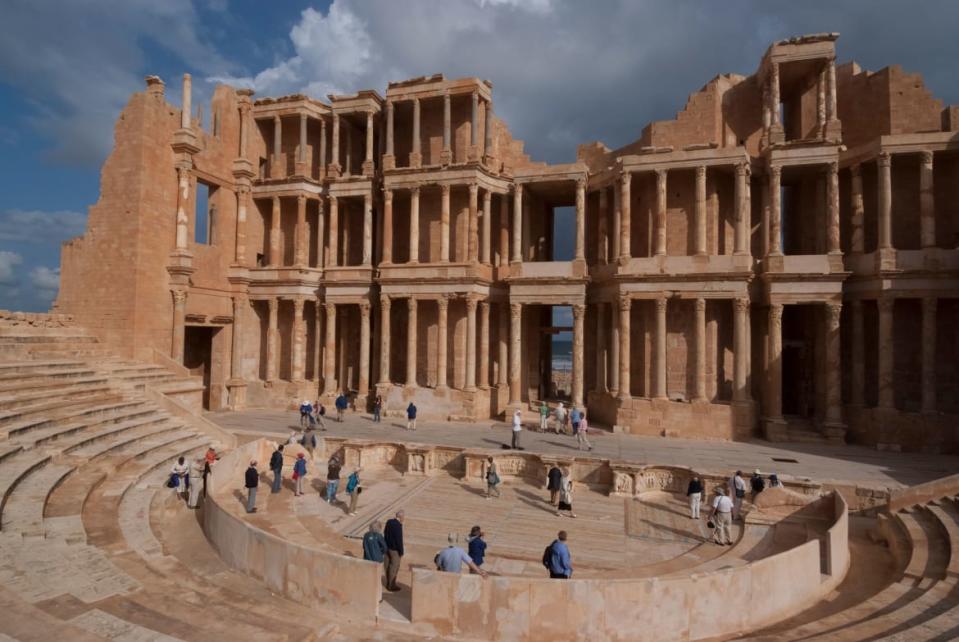The Beatles Nearly Made This Ancient Wonder Famous

Celebrity news has put an ancient Libyan city back on the cultural map. Last week, Peter Jackson, famed director of the Lord of the Rings trilogy, released the three-part miniseries Get Back on Disney+. The six-hour film is based on seen and unseen footage from the making of the 1970 movie Let it Be. The original was filmed in the aftermath of the band’s decision to stop touring in order to focus on recording music in the studio. While recording what would become their last studio album in 1969, the Beatles did a final one-off show on the roof of Apple Corps headquarters in London. That now-iconic performance, however, came close to being filmed in the ruins of a Roman theater in North Africa.
The show was planned with only two weeks’ notice and at the time potential venues ranged from the traditional—like the Royal Albert Hall or Tate Gallery in London—to the subversive. Paul was apparently keen on an unsanctioned gig in the Houses of Parliament that would culminate in them being forcibly removed by London’s police force. Michael Lindsay-Hogg, the director of the 1970 film, however, was lobbying for a more ancient setting.
The plan was to take a cruise ship to Libya, rehearse en route, and perform in the ruins of amphitheater in Sabratha. According to journalist John Harris, John Lennon was enthusiastic and McCartney was up for the adventure. George Harrison, on the other hand, thought the whole idea was “very expensive and insane.” In the end the idea was quashed, and the rest is history.
In hindsight, Sabratha could have used the publicity.
Sabratha lies about 43 miles to the west of modern-day Tripoli and was probably founded around 500 B.C. by the ancient Phoenicians as a trading post on the coast. The city was annexed as part of a Roman province in the first century A.D. and was Romanized thereafter. Extensive rebuilding projects in the second and third centuries turned Sabratha and its neighboring cities of Oea and the (better known) Leptis Magna into a cosmopolitan Roman Tripolis (Tripolis, from which we get the modern Tripoli, literally means “three cities”). Though Leptis Magna had been a major city since the first century, the building projects brought prominence and attention to the region.

They were also what might be called a passion project. The cities were expanded by the Roman emperor Septimius Severus, who grew up in Leptis Magna, and favored the region as a result. The flow of wealth into the area made Leptis Magna one of the most important cities in Africa and Sabratha and Olea were along for the ride. The beautifully preserved ruins include a Christian Basilica, temples dedicated to Serapis and Isis, and the remarkable three-story theater in which the Beatles planned to perform.
In recent years, however, Sabratha has not fared so well. For the past decade, and as a result of the political unrest that followed the Arab Spring, the area’s cultural heritage has been under threat. Since the nine-month Civil War that culminated in Gaddafi’s capture and death in October 2011, Libya has been engaged in a second more protracted conflict between rival groups and armed militias. A ceasefire was reached in October 2020 but, as was the case in Egypt and Tunisia, the nine years of fighting provided cover for the destruction and looting of antiquities.
In 2016 the World Heritage Committee added Sabratha (and four other Libyan archeological sites) to the list of endangered world heritage sites. In a statement that year, senior Libyan archaeologist Ramadan Shebani, said that antiquities were “gushing out” of Libya onto the black market. The looting was hard to control as much of it involved people digging under their houses or in the desert. Some was more strategic, however. Shebani referred to online advertising “for selling and buying Libyan statues and antiquities.” Looting to order was a real problem as unscrupulous auction houses, dealers, and buyers sought to take advantage of the lack of oversight and centralized government.
Not all the damage to Sabratha and other Libyan World Heritage Sites was a result of looting or warfare. Many sites of interest were vandalized with graffiti, while some people built homes in areas of historical and archaeological interest. A 2013 law that allowed Libyans to reclaim land seized from them during Gaddafi’s regime only exacerbated the problem of urban encroachment on archeological sites. Some reclaimed land that they felt was owed to them rather than just land that had been seized.
Throughout this period of unrest Sabratha was repeatedly affected by fighting between warring groups that included ISIS. ISIS has maintained a militia presence in the city since December 2015. When they briefly captured the security headquarters in early 2016, they beheaded twelve security officers in the building. The scale of the fighting altered the city’s demographics: as residents fled, the city became a hub for migrants trying to reach Europe. Italian-backed militias were paid to stem the tide of illegal immigrants. In 2017 UNESCO’s Director-General appealed for help in “safeguarding…Sabratha’s unique cultural heritage” but assistance did not materialize. Earlier this year a man was arrested for looting objects from an archaeological site in Sabratha.
That the looting and armed conflict in Libya took place at the same time as similar destruction in Syria only added to Sabratha’s troubles. As Oberlin art historian Susan Kane told The Art Newspaper in 2016, the focus on Syria and Palmyra meant that Libya’s heritage was overlooked. Writing for Hyperallergic, archaeologist Michael Press agreed arguing that antiquities have been weaponized in order to justify military intervention against ISIS in Syria while looting by other groups and in other countries have been ignored. Powerful foreign governments, international organizations, and wealthy corporations with the ability to help have limited and somewhat hyper focused attention.
In his work, Press has shown that the interest of Western media and governments in threats to cultural heritage revolves around regions that are relevant to Western histories. Syria and Iraq are home to monuments, objects, cities, and architecture that are connected to biblical and classical narratives. The destruction of the tomb of Jonah by ISIS in 2014 received attention precisely because Jonah is a biblical hero and prophet. It’s damning that our concern about cultural heritage is actually about our self-interest, but if it is then it is worth noting how things might have been different if the Beatles had performed in Sabratha rather than London. Perhaps the association of Sabratha with the most influential band in pop music history might have cultivated affection for site and grandfathered it into our rather self-absorbed history. This is not to say that John, Paul, Ringo and George could have saved Sabratha if they had taken the stage in one of the jewels of the Roman Empire, but that we might care more if they did.
Get our top stories in your inbox every day. Sign up now!
Daily Beast Membership: Beast Inside goes deeper on the stories that matter to you. Learn more.

 Yahoo Finance
Yahoo Finance 